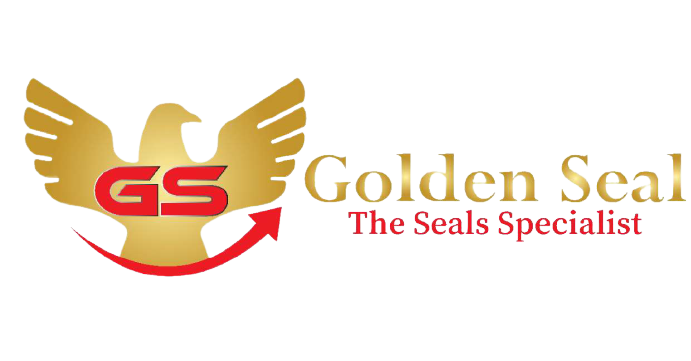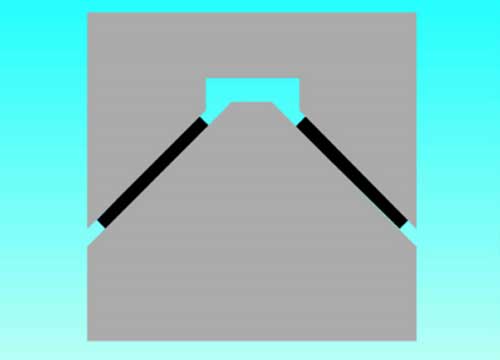- Hydraulic Rod Seals
- Hydraulic Piston Seals
- Hydraulic Wiper Seals
- Pneumatic Rod Seals
- Pnuematic Piston Seals
- Guiding Elements
- Static Sealing Elements
- Rotary Shaft Seals
- Axial Face Seals
- Bonded Seal
- End Cap Seal
- Mechanical Seals
- Single Spring Mechanical Seal
- Apv Pump Seal
- Famous Pump Seals
- Metal Bellows Seals
- Auto Cooling Pump Seal
- Flygt Pump Seal
- Inflatable Seals
Our Brochure
View our new brochure for an easy to read guide on all the products we offer.
TURCITE SHEETS
OVERVIEW OF TURCITE® B SLYDWAY SHEET
Turcite® B Slydway – Linear Bearing Material
Turcite is PTFE (polytetrafluoroethylene) resins with added fillers such as bronze, that are extruded into solid billets as opposed to compression molding. Billets are then skived to a nominal thickness in 24″ wide rolls, with lengths varying depending on thickness. One side or both sides are etched depending on application to accept the adhesive. Turcite® B is a polytetrafluoroethylene (PTFE) based bearing material with low friction for machine tool industry linear bearing applications.
- 1) Turcite B comes in 12″ and 24″ wide rolls, or custom cut to your specifications.
- 2) Rolls up to 60 feet long are available upon request (lead-time may apply)
- 3) Bond Turcite® B to steel surfaces with Waylock® Adhesive
Testing has shown that PTFE based compounds are resistant to virtually all media, cutting fluids and slideway oils. Additionally, these compounds feature outstanding wear resistance and friction characteristics. Head-to-head material testing has shown that Turcite B outperforms key competitive materials for low friction. Turcite B was developed to meet the needs of machine tool manufacturers looking to improve machine tool efficiencies through low friction material technology and reduce stick-slip effect in machine transitions while still maintaining positioning accuracy and vibration damping.
OVERVIEW OF TURCITE® B SLYDWAY SHEET
Features and Benefits of Turcite® B:
- 1) Low friction without stick slip for positional accuracy at different velocities, especially low speeds
- 2) Low coefficient of friction in intermittent lack of lubrications
- 3) Chemical resistant to a broad range of lubricants for extended product life
- 4) Reduces machine tool vibration through damping characteristics
- 5) Minimal abrasion of hardware, preventing damage to counter surfaces
- 6) High wear resistance for extended product life
- 7) Thicknesses to meet design requirements
The information in this brochure is based on many decades of experience in the manufacture and application of sealing and bearing systems. However, unknown parameters and conditions may restrict general statements during usage. It is vital that Customers satisfy themselves as to the suitability of individual products through adequate testing. For this reason, and due to the wide range of applications of our products, Busak+Shamban can accept no liability as to the suitability or correctness of our recommendations in individual cases.
The application limits for pressure, temperature, speed and media given in this catalogue are maximum values determined in the laboratory. During practical applications it should be remembered that due to the interaction of the operating parameters, the maximum values must be set correspondingly lower. For exceptional operating conditions, please contact your Busak+Shamban representative.
This edition supersedes all previous catalogues. This catalogue, or any part thereof, may not be reproduced without our permission.
®All trademarks are the property of Busak+Shamban, Dowty Engineered Seals, Forsheda. QUAD-RING® is a trademark of Quadion Corporation.
@Busak+Shamban. All rights reserved.
The turquoise colour is a registered trademark of Busak+Shamban.
GENERAL
Tsdts® Slydway®. is a high performance thermoplastic material for use on linear bearing application as found on the guideways of machine tools and other linear bearing applications. Guideways on machine tools ensure the exact direction of motion of components such as slides, sleeves, quills, plungers, etc. At the same time, guideways must bear the weight of the guided components and workpieces and absorb the machining forces without deformation. This places critical demands on the machine tool guideways:
- 1) High accuracy and repeatability of the working movements
- 2) High performance over many years
- 3) Low production costs
- 4) Low friction without stick-slip as a precondition for positional accuracy at differing velocities
- 5) Low wear, even in the event of poor or failed lubrication
- 6) Backlash-free or minimum backlash for high repeatability even under load
- 7) Good damping behaviour even with interrupted cutting operations to minimize chatter.
®Turcite. ®Slydway has been well proven worldwide for many years in many sectors of machine tool and other heavy duty engineering industries (see Figure 1).
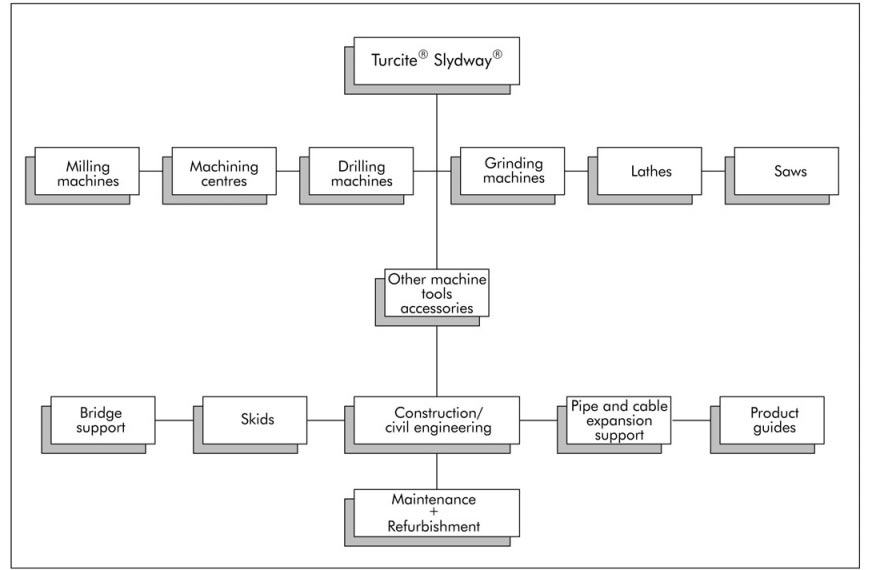
Figure 1 Fields of Application for ®Turcite. Slydwoy®.
APPLICATION
Slydway® can be used in a wide variety of applications. The application examples show forms of sliding slydways® coated with Turcite®. already in use in the machine tool industry (figure 2 on page 4). Slydway® is also applicable to other heavy duty linear bearings in the construction or civil engineering markets including bridge supports, skids, pipe or cable expansion supports, telescopic arms or any other linear application. Slydway®’) is normally bonded to the moving surface only of a linear bearing application. It is subsequently finish machined by milling, grinding and/or scraping to provide a suitable counterface to the cast iron, steel or other static face.
DESIGNS
Slydwayc® meets the modern demands mode by different guide systems and dimensions. It is available in thicknesses of 0.5 to 5 mm and widths up to 300 mm. It can be supplied cut to the specified length or as off-the-roll material. Table III, page 10, shows the standard sizes available. Slydway® is especially applicable to the refurbishment of worn machine tools. Worn linear bearings can be machined back and brought to the original working tool heights and centre lines by the application of Slydway®. material of suitable thickness.
CHARACTERISTICS
Slydway® is manufactured from the specially developed high-performance thermoplastic Turcite®. and modified for the special requirements for linear bearing applications. In order to achieve good adhesion when bonding with the machine components, the surface is chemically treated.
ADVANTAGES
- 1) low friction, no jamming, no stick-slip, particularly at low sliding speeds
- 2) good mechanical properties, wear-resistant and dimensionally stable
- 3) safaty against dry running in the event of poor or no – lubrication
- 4) high wear resistance, thus ensuring a long service life
- 5) good emergency running properties, no tendency to seize
- 6) damps and absorbs vibrations
- 7) impervious to soiling and moisture
- 8) chemically resistant to aggressive cooling lubricants
- 9) dimensions available from stock, simple and cost-effective handling.
Material characteristics – Turcite’ TB
| Only one side is chemically treated for applying adhesive | |||||
| Colour of the treated surface: brownt dark brown Colour on the non-treated surface (sliding surface): | green-grey | ||||
| Water absorption: | < 0.01 % | ||||
| Linear coefficient of expansion: | 6 x 10-5 1/K | ||||
| Thermal conductivity at 20 °C: | 0.8 W/m • K | ||||
| Max. pressure load for 1% deformation: | 930 N/cm2 | ||||
| Hardness: | 60 Shore D | ||||
| Hardness: | 60 Shore D | ||||
| Modulus of elasticity at 40°C: | 1.000 N/mm2 | ||||
CHEMICAL RESISTANCE:
Turcite® TB has a very good chemical resistance and is resistant to coolants, clear coolants and lubricants.
Material characteristics – Turcite® T51
| Both sides are chemically treated and can both be used for applying adhesive: | |||||
| Colour of the treated surfaces: | black | ||||
| Colour after machining the treated surface (sliding surface): | black | ||||
| Water absorption: | < 0.01 % | ||||
| Linear coefficient of expansion: | 1 x 10-4 1/K | ||||
| Thermal conductivity at 20°C: | – | ||||
| Max. pressure load for 1% deformation: | – | ||||
| Hardness: | 66 Shore D | ||||
| Modulus of elasticity at 40°C: | 1.000 N/mm2 | ||||
CHEMICAL AND MECHANICAL RESISTANCE:
Turcite® 151 has good resistance against lubricated and poor lubricated moving components. Good sliding properties against soft metal surfaces – see “Mating surfaces” on page 7.
CHEMICAL AND MECHANICAL RESISTANCE:
Slydway® should be stored at room temperature and in dry environments protected from light. The shelf life is limited and depends on the storing conditions.
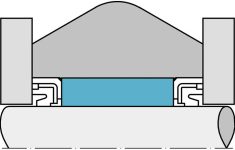
DESIGN INSTRUCTIONS
Load and contact deformation
In conjunction with the contact deformation, the load is of great significance for the operating precision of the linear bearing. The surface pressures for Turcite® Slydway®. in machine tool construction are generally selected between 20 and 200 N/cm2. The load-carrying capacity is dependent on the thickness of the Turcite®. bearing material and the surface roughness. Figure 3 shows the contact deformation as a function of different material thicknesses “w” for Turcite®. TB with a surface roughness of B = 0.6 ttm. As can be seen from the diagram, Turcite®. TB can be subjected to even more than the optimum range. Within the working range depicted, the coefficient of fridion of the Turcite®. TB material remains practically unchanged.
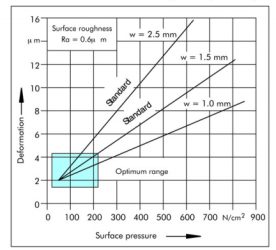
Figure 3 Deformation as a function of surface pressure and thickness “w” of the Turcite®. TB material
SURFACE ROUGHNESS
Turcite® TB and Turcite® T51 sliding surfaces can be finish machined by milling, grinding and/or scraping. The surface quality should be Ro = 0.6 pm. Minor deviations such as shown in figure 4 have an insignificant effect on the friction behaviour. However, with greater surface roughnesses the contact deformation and wear would increase. M insufficient surface roughness influences the sliding behaviour as the sliding surfaces stick together (adhesion).
Figure 4 shows an optimum surface roughness range which should be achieved during final machining of the surface.
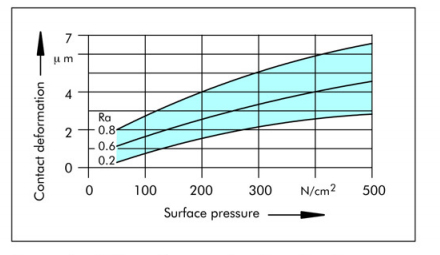
Figure 4 Deformation as a function of surface pressure for different surface roughness
COEFFICIENTS OF FRICTION
In use Slydway® displays only a slight difference between static friction and dynamic friction, thus eliminating any stick-slip. When used in numerically controlled machines, this produces higher positioning and reproduction precision.
STATIC FRICTION
The coefficient of static friction for a Slydway® bearing depends on the material pairing in question and on the surface roughness of the Turcite® -B sliding surface, on the mating surface and on the lubrication.
Figure 5 shows the range of static friction when using different oils. The values were determined on a scraped Turcite® . TB sliding surface with a surface contact pressure of 35 N/cm2 and a surface roughness of the guide of Ra = 0.6 pm.
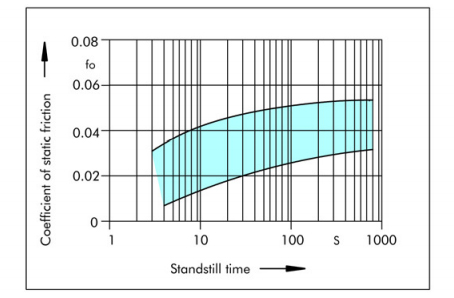
Figure 5 Range of the coefficient of static friction 4) for Turcite® TB as a function of the standstill time when using different lubricants
DYNAMIC FRICTION
The dynamic friction for a Slydway® has a practically linear pattern over the whole speed range. The good material pair of Turcite®. TB and hardened steel guides can be clearly seen in the mixed friction zone. With a combination of a surface load of 35 N/cm2 and a scraped Turcite® TB surface, the coefficient of friction reaches
f = 0.022 – 0.055.
Figure 6 shows the least differences at the transition to the hydrodynamic range. With higher surface pressures of up to 200 N/cm2, the sliding behaviour changes only insignificantly.
Good lubrication is of paramount importance in order to achieve a controlled level of dynamic friction.
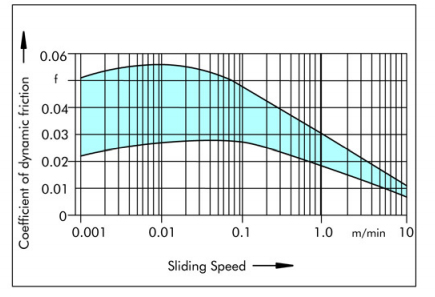
Figure 6 Range of the coefficient of dynamic friction (f) as a function of the sliding speed when using different lubricants
WEAR
The service life and the continuous precision of Slydway® is determined primarily by its wear behaviour. Slydway® linear bearing are generally supplied with adequate lubrication. Should the lubricant supply suddenly be interrupted, Slydway® will remain functional with low wear even for prolonged periods due to the self-lubricating properties of the material. Very It wear rates are achieved using the combination of Slydway® and hardened mating surface. The wear behaviour is determined to a great extent by the ambient influences. It is important to protect the guides from external soiling by using covers and seals. Slydway® has the great advantage of being able to absorb and embed small did particles, thus preventing immediate seizing, damage and extreme wear of the guides.
START-UP PHASE
A linear bearing application, using Slydway® should always be well lubricated during the start-up phase. During the start-up phase, very fine particles of the Turcite material are deposited on the mating surfoce. This leads to a slight shading of the metallic running surfaces. The start-up phase is then concluded with the smoothing phase. A very low level of friction and wear is then reached which remains essentially constant (Figure 7). The guides can then be used for continuous operation.
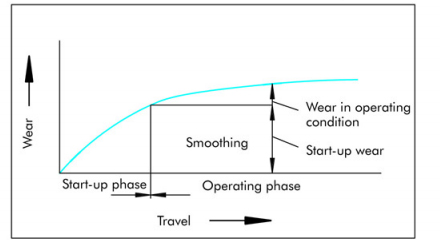
Figure 7 Wear as a function of the operating condition
SLIDING WEAR
Slydway® are set backlash-free or even slightly preloaded, thus ensuring s very high continuous precision even over many years. The sliding behaviour is then determined primarily by the lubricant and the surface finish. Figure 8 shows the wear behaviour of a scraped Turcite® TB Slydway® with a mean load of 50 N/cm2 with adequate lubrication.
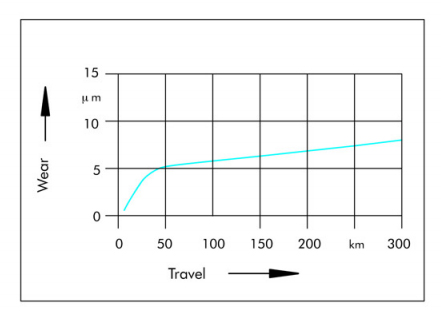
Figure 8 Wear behaiviour of Turcite® TB Slydway®
MATING SURFACES
In order to ensure a long service life, demands must also be made on the surface finish of the mating surface. The following values are recommended:
for steel –
- Ra = 0.2 t0 0.4 µm
- Rz = 1.6 to 3.2 µm
- Rmax = 2.5 t0 5.0 µm
for grey cast iron –
- Ra = 0.2 to 0.8 µm
- Rz = 1.6 to 6.3 µm
- Rmax = 2.5 to 10.0 µm
(These figures are only valid for Turcite® TB Slydway®. and Turcite® T51 Slydway® applications).
Steel and cast iron are frequently used as materials for mating surfaces. Hardened mating surfaces are generally preferred for precision guides subject to high loads. In practice, hardnesses of approx. 60 HRc for steel and approx. 240 HB for cast iron have been found to be effective.
These sliding surfaces are not normally subject tany wear. For guide systems subject to less wear, unhardened and wear-resistant mating surfaces can also be used. Mating surfaces of bronze, aluminium (untreated) or plastics – please contact your local Busak +Shamban Company for further information.
TEMPERATURE
The temperature at the sliding surfaces should be kept as constant as possible. In the event of elevated temperatures, an adequate heat dissipation must be assured by means of lubrication.
INSTALLATION INSTRUCTIONS
Fixing Slydway® material
Slydway® material is fixed to the base material by bonding. Performed with the necessary care, bonding is a reliable and inexpensive fixing method.
Surface Preparation:
The preparation of the parts u be bonded together is of ultimate importance for achieving a good bond.
The preparation of the parts u be bonded together is of ultimate importance for achieving a good bond. Machining of the adhesive surface is crucial for optimum bonding of Slydway®. To a certain extent, the surface roughness assists the bonding ability of the adhesive.
Surface roughness Ra = 0.8 to 3.2 µm.
Additional possibilities of roughening the surface ore sandblasting and rubbing with emery cloth (grain size: 100).
CLEANING THE SURFACE FOR BONDING
Before applying the adhesive, the bonding surfaces must be cleaned thoroughly and freed from oil, grease, dust and rust. Impurities can be removed by washing with a commercially available degreasing agent such as acetone (oil-free), etc. When refurbishing machine tools with cast iron surfaces, flame treating of the porous surface remove embedded oil deposits may be beneficial.
BONDING SLYDWAY®
Slydway® should be bonded in a clean environment and at normal room temperature, ideally 20’C. A good two-component epoxy-resin adhesive is used. After mixing, apply the adhesive components 5 both parts to be bonded using a serrated spatula. Place Slydway®. material onto the surfaces to be joined and bad them uniformly to eliminate any air and excess adhesive.
IMPORTANT NOTE:
- 1) Turcite TB is treated for bonding on one side only !
- 2) Apply adhesiveA the dark brown side only
- 3) Try AavAd adhesive on this side
The pads should not shifted relative to one another during the prescribed hardening time. Finish machining of the Slydway® surface is carried after the adhesive has hardened. We can offer a Busak+Shamban two-component epary-resin adhesive. Please send for our detailed bonding instructions.
SAFETY PRECAUTIONS
When bonding Slydway® with epoxy-resin adhesives, the safety precautions in accordance with DIN 52900 must be observed. The working areas should be adequately ventilated. Smoking should be avoided during bonding and machining.
MACHINING
Slydway® ” can be machined mechanically after the bonding point has set. Slydway® materials can be machined quite easily.
MACHINING METHODS
Precision Milling
For precision milling tools such as face cutters with one or more cutting edges made from high-speed steel, tungsten carbide or ceramic materials can be used.
Surface qualities such as those achievable when grinding can be produced with high cutting rates (up to 800 m/min) and Is feed rates. In order to achieve a good surface finish, a small cutting depth is to be recommended.
No cooling is generally needed when milling Slydway®
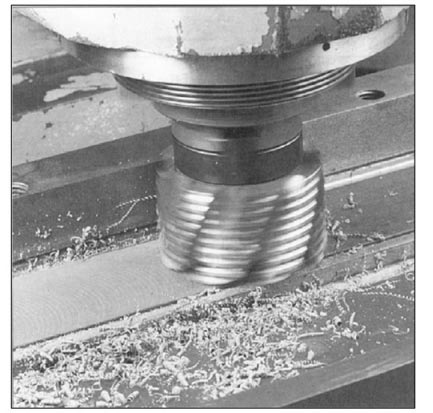
Figure 9 Precision Milling
GRINDING
Grinding wheels with normal abrasives (e.g. special fused alumina, silicon carbide can be used for grinding. The grinding wheels should have a medium grain (36) and a low hardness (I). The method of bonding can be ceramic (Ke) or may contain synthetic resin (Ba). We grinding is always recommended for grinding of Slydway®. The coolant dissipates the heat of grinding and provides a better surface finish. Grinding wastes have to be removed.
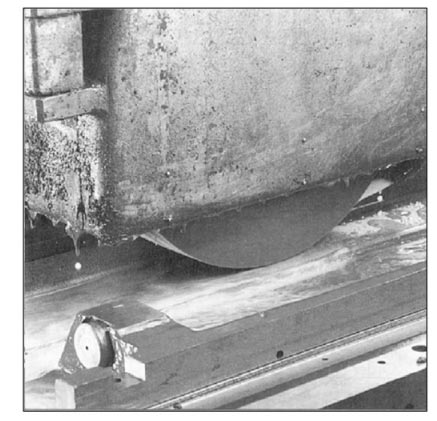
Figure 10 Grinding
SCRAPING
Milled and ground surfaces can be remachined by scraping to improve the surface quality and dimensional accuracy. Only sharply ground scraping tools should be used. Scraping can be performed manually or with a scraping machine. A grade of 2 is required for a precision surface, corresponding to 2 to 3 points per cm2. A perfectly scraped or patterned surface enhances the tribological properties of the guides.
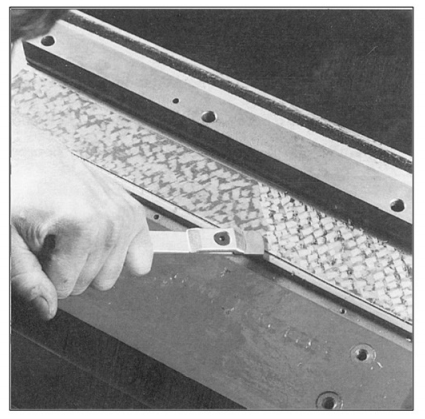
Figure 11 Scraping
OIL GROOVES
Slydway® can be machined to incorporate oil or lubrication groove patterns. The configuration of the groove is optional. The optimum result is obtained by milling the oil grooves into the material to a depth of 0.5 – 0.6 mm. Milling completely through the material into the metal saddle is not recommended. For any pattern chosen, it is extremely important that the milled grooves maintain a generous, smooth radius which blends the top of the groove back to the surface of the material without creating any sharp edges. Oil grooves should never be machined closer than 6 mm to the edge and 15 mm from the ends of the bearing material.
DIMENSIONS / ORDERING
Slydway® is available cut to length or off-the-roll. Standard strip thicknesses are 1.5 and 2.5 mm. Other thicknesses up to 5.0 mm are available on request. The standard widths are shown in Table III. Other widths up to 300 mm can also be supplied. For the standard dimensions, please use the order numbers from Table III. The desired length (m) has to be stated with the order number.
Limitations:
- 1) Up to and inclusive 3.0 mm thickness Turcite® TB can be delivered one-side treated, up to 300 mm width.
- 2) Up to and inclusive 3.5 mm thickness all standard materials, except Turcite® TB, can be delivered two-side treated, up to 200 mm width.
- 3) 3. Up to and inclusive 4.0 mm thickness all standard materials, except Turcite® TB, can be delivered two-side treated, up to 140 mm width.
- 4) 4. Up to and inclusive 5.0 mm thickness all standard materials, except Turcite® TB, can be delivered two-side treated, up to 60 mm width.
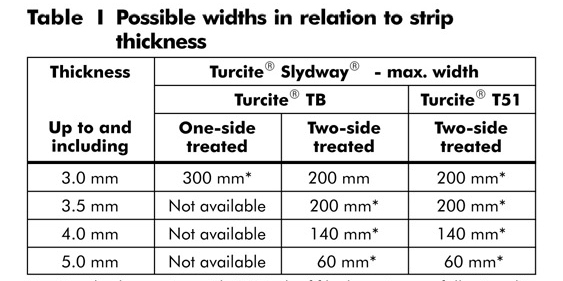
Standard execution with “0” in the fifth character are following this limitations
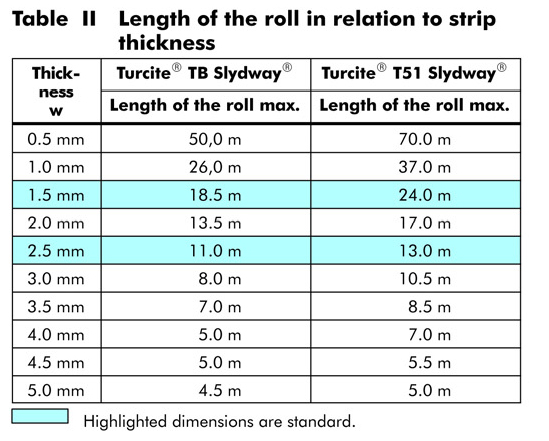
ORDERING EXAMPLE
1 roll (thickness 1.5 mm, length 18.5 m, width 35 mm)
Materials : Turcite® TB

QUALITY CRITERIA
The cost-effective use of seals and bearings is highly influenced by the quality criteria applied in production. Seals and bearings from Busak+Shamban are continuously monitored according to strict quality standards from material acquisition through to delivery.
Certification of our production plants in accordance with international standards QS 9000 / ISO 9000 meets the specific requirements for quality control and management of purchasing, production and marketing functions.
Our quality policy is consistently controlled by strict procedures and guidelines which are implemented within all strategic areas of the company.
All testing of materials and products is performed in accordance with accepted test standards and specifications, e.g. random sample testing in accordance with DIN ISO 2859, part 1. Inspection specifications cur I espond iu siandulds applicable lu individual product groups (e.g. for 0-Rings: ISO 36011.
Our sealing materials are produced free of chlorofluorinated hydrocarbons and carcinogenic elements.
The tenth digit of our part number defines the quality characteristics of the part. A hyphen indicates compliance with standard quality criteria outlined in this catalogue. Customer-specific requirements are indicated by a different symbol in this position. Customers who require special quality criteria should contact their local Busak+Shamban sales office for assistance. We have experience in meeting all Customer quality requirements.
STORAGE AND SHELF LIFE
Seals and bearings are often stored as spare parts for prolonged periods. Most rubbers change in physical properties during storage and ultimately become unserviceable due, e.g., to excessive hardening, softening, cracking, crazing or other surface degradation. These changes may be the result of particular factors or combination of factors, such as the action of deformation, oxygen, ozone, light, heat, humidity or oils and solvents.
With a few simple precautions, the shelf life of these products Lon be considerably lengthened.
Fundamental instructions on storage, cleaning and maintenance of elastomeric seal elements are described in international standards, such as:
DIN 7716 / BS 3F68:1977,
ISO 2230, or
DIN 9088
DIN 7716 / BS 3F68:1977,
ISO 2230, or
DIN 9088
The standards give several recommendations for the storage and the shelf life of elastomers, depending on the material classes.
The following recommendations are based on the several standards and are intended to provide the most suitable conditions for storage of rubbers. They should be observed to maintain the optimum physical and chemical values of the parts:
HEAT
The storage temperature should preferable be between +5 °C and +25 °C. Direct contact with sources of heat such as boilers, radiators and direct sunlight should be avoided.
If the storage temperature is below +15 °C, care should be taken to avoid distorting them during handling at that temperature as they may have stiffened. In this case the temperature of the articles should be raised to approximately +20 °C before they are put into service.
HUMIDITY
The relative humidity in the store room should be below 70%. Very moist or very dry conditions should be avoided. Condensation should not occur.
LIGHT
Elastomeric seals should be protected from light sources, in particular direct sunlight or strong artificial light with an ultraviolet content. The individual storage bags offer the best protection as long as they are UV resistant.
It is advisable to cover any windows of storage rooms with a red or orange coating or screen.
RADIATION
Precaution should be taken to protect stored articles from all sources of ionising radiation likely to cause damage to stored articles.
OXYGEN AND OZONE
Where possible, elastomeric materiels should be protected from circulating air by wrapping, storage in airtight containers or by other suitable means.
As ozone is particular deleterious to some elastorneric seals, storage rooms should not contain any equipment that is capable of generating ozone, such as mercury vapour lamps, high voltage electrical equipment, electric motors or other equipment which may give rise to electric sparks or silent electrical discharges. Combustion gases and organic vapour should be excluded from storage rooms alas they may give rise to ozone via photochemical processe
DEFORMATION
Elastomeric materials should, wherever possible, be stored in a relaxed condition free from tension, compression or other deformation. Where articles are packed in o strain-free condition they should be stored in their original packaging.
CONTACT WITH LIQUID AND SEMI-SOLID MATERIALS
Elastomeric seals should not he allowed to come into contact with solvents, oils, greases or any other semi-solid materials at anytime during storage, unless so packed by the manufacturer.
CONTACT WITH METAL AND NON-METALS
Direct contact with certain metals, e.g. manganese, iron and particularly copper and its alloys, e.g. brass and compounds of these materials are known to have deleterious effects on some rubbers. Elastomeric seals should not be stored in contact with such metals.
Because of possible transfer of plasticisers or other ingredients, rubbers must not be stored in contact with PVC. Different rubbers should preferably be separated from each other.
CLEANING
Where necessary, cleaning should be curried out with the aid of soap and water or methylated spirits. Water should not, however, be permitted to come into contact with fabric reinforced components, bonded seals (because of corrosion) or polyurethane rubbers. Disinfectants or other organic solvents as well as sharp-edged objects must not be used. The articles should be dried at room temperature and not placed near a source of heat.
SHELF LIFE AND SHELF LIFE CONTROL
The useful life of a elastomeric seals will depend to a large extend on the type of rubber. When stored under the recommended conditions (above sections) the below given shelf life of several materials should be considered.
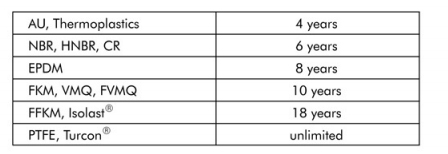
Elastomeric seals should be inspected after the given period. After this giving on extension period is possible.
Rubber details and components less than 1.5 mm thick are liable to be more seriously affected by oxidation degradation even when stored in satisfactory conditions as recommended. Therefore they may be inspected and tested more frequently than it is mentioned above.
RUBBER DETAILS / SEALS M ASSEMBLED COMPONENTS
It is recommended that the units should be exercised at least every six months and that the maximum period a rubber detail be allowed to remain assembled within a stored unit, without inspection, be a total of the initial period stated above and the extension period. Naturally this will depend on the design of the unit concerned.
APPLICATIONS
- Automotive
- Fluid Power
- Electronics
- Hydraulic Fittings
- Valves and Pumps
- Earthmoving & Construction Equipment
- Power Generation
- Instrumentation
- Filtration
- Hydraulic Cylinders
- Plumbing Products
- Petrochemicals
- Chemicals & Fertilizer Plants
- Pharmaceuticals
- Pneumatic Cylinders
- Dairy/Food Processing
